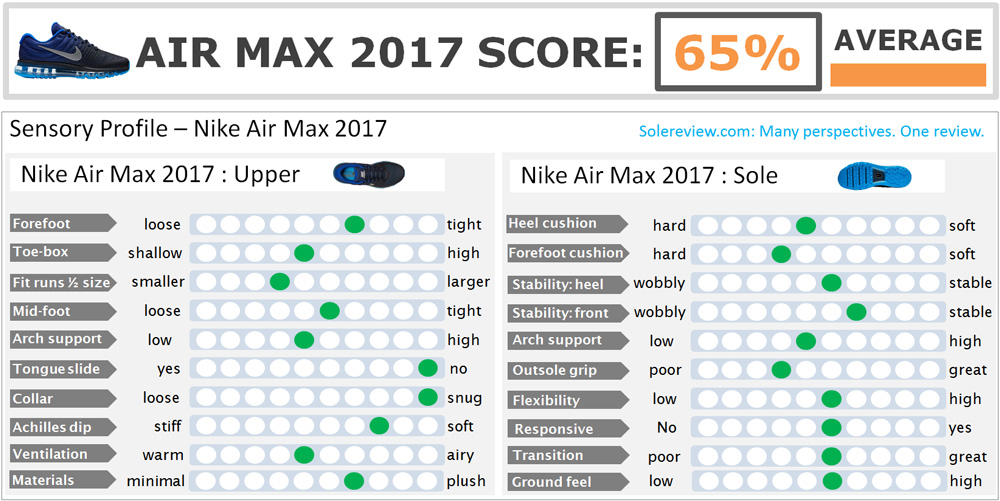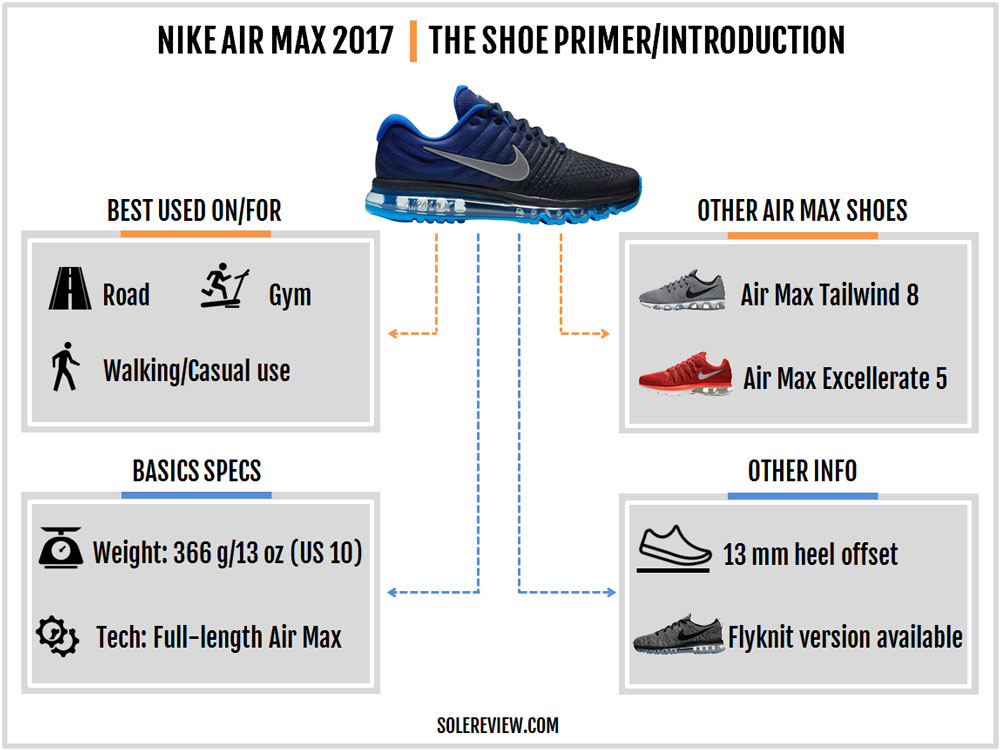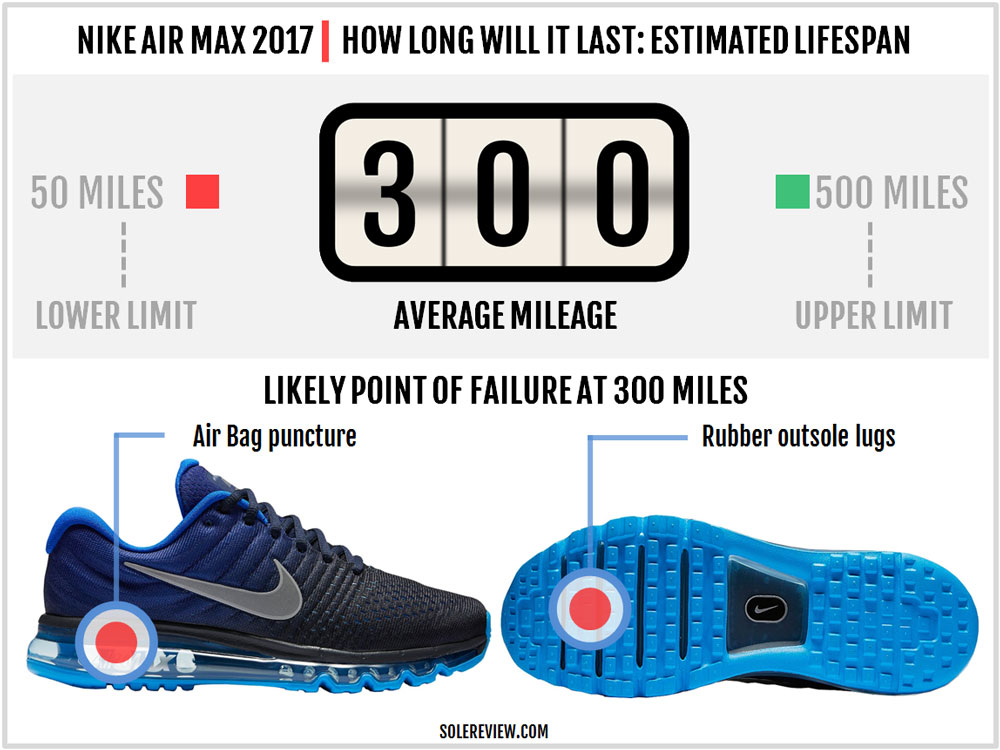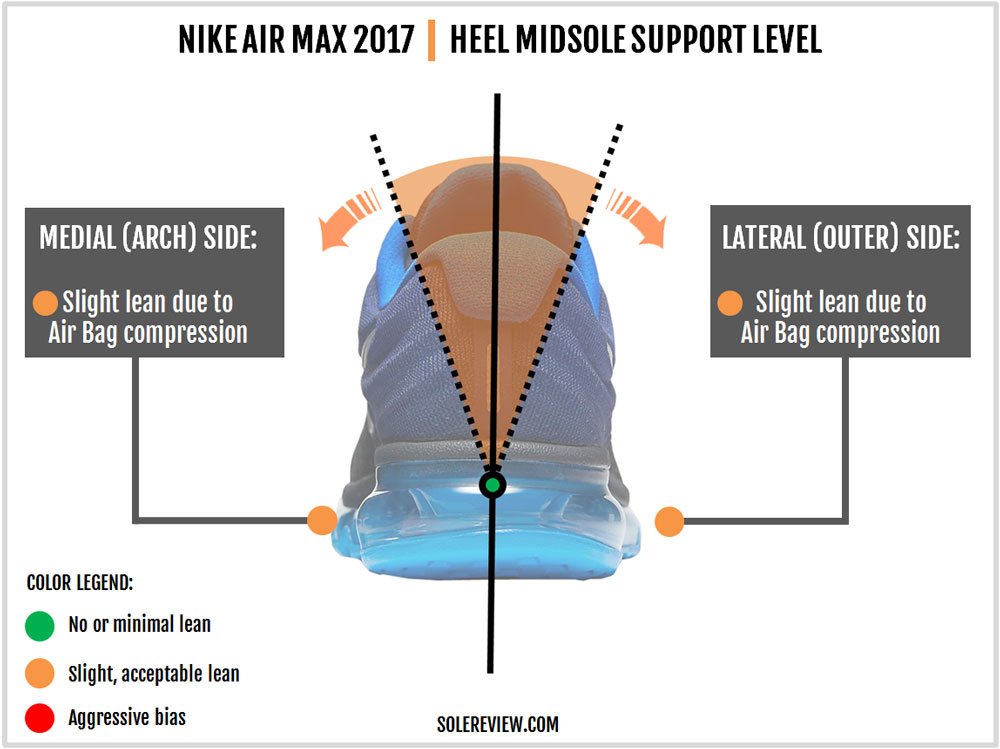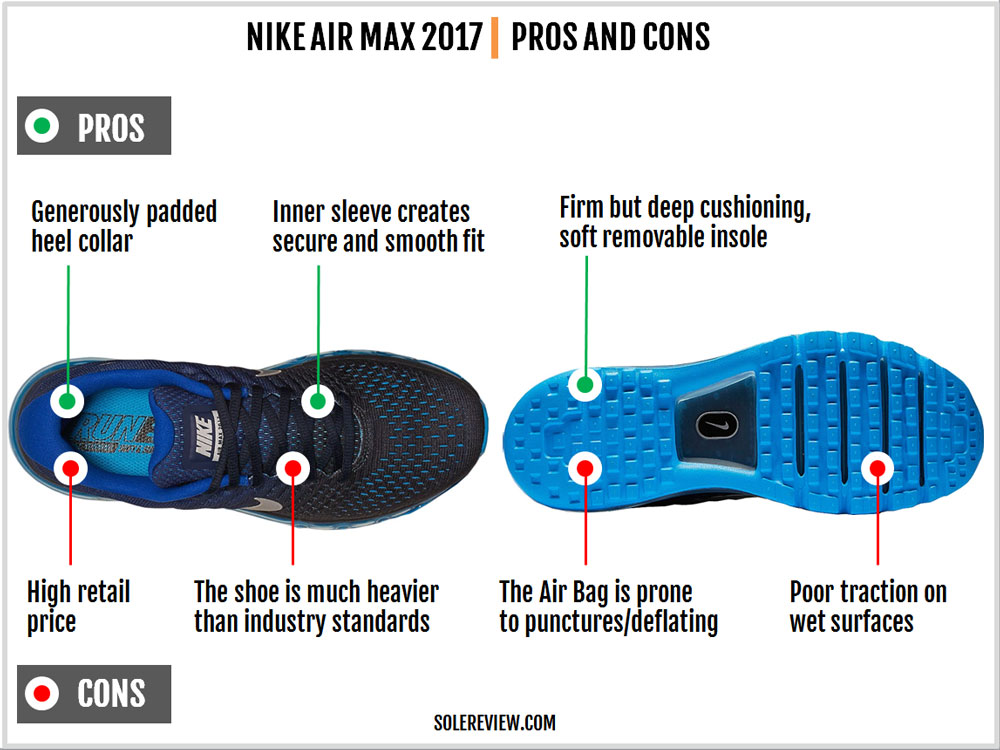INTRODUCTION
The fact that the Nike Air Max 20xx series has been the most counterfeited sports footwear style in recent times is a testament to its mass appeal as a casual shoe.
Some of the rip-offs are so well made that it’s hard to tell them apart. And why doesn’t Nike go after these guys? Because the process will end up becoming the footwear version of whack-a-mole, with too much energy spent for little results.
The best way in this scenario would be to move forward, which brings us to the Air Max 2017.
The Air Max platform might have fallen out of favor with serious runners, but it still helps Nike sell shiploads of shoes. When the first AM version – the Air Max 2006 to be precise – made its public appearance over a decade ago, plenty of Nike running shoes still came with Max Air heels.
Old timers will remember the popular Air Max Moto and other ‘tiered’ versions of the Air Max 2006 such as the Air Max 180 and 90. But it’s soon going to be 2017, and the running shoe landscape has evolved by leaps and bounds.
When compared to some of the best running shoes in the market today (including Nike’s), Air Max infused running shoes look and ride like a marketing gimmick. As of today, there are five Air Max models categorized as performance running shoes by Nike.
Besides the Air Max 2017, there’s the Air Max Sequent 2, the Air Max Excellerate 5, and the Air Max Tailwind. There’s a Flyknit iteration of the Air Max which retails at an eye-watering MSRP of $225.
Like the regular AM17, none of these models make the grade as a performance running shoe. Even so, Nike knows that it has to pander to the needs of the casual consumer as much as it needs to meet the requirements of serious runners. That is ok, but then Nike should make a clear distinction between the two, and not slot these products in the performance running category.
As we said in our adidas Alphabounce write-up, adidas and Nike do a terrible job at separating these two categories. Or maybe it’s intentional double-dipping, which is an equal sin.
DESIGN AND MATERIALS
The blown Air bag midsole and the outsole has been exactly the same for the past few years now, so the changes take place only on the new upper. The 2017 model drops the Flywire based upper (of the AM16) for a molded mesh design, and also includes a lot of other updates.
The AM17’s upper is visually cleaner than the 16. That’s the result of eliminating the forefoot Swoosh logo and the Flywire cords over the midfoot. Instead, the upper uses traditional round laces which are routed through regular eyelets.
The Swoosh logo is placed on both sides of the midfoot, a move which also makes the AM17 appear more streamlined. Reflectivity gets a huge upgrade over both the AM15 and 16. Both the Swoosh logos are reflective, and that applies to the tongue-top label and the heel strip too.
On the AM16, all the reflectivity was focused over the heel, so the 2017 update does a stellar job in this department. Not only has the amount of reflectivity increased, but is spread uniformly over the upper too.
The outer upper is made of a single-piece engineered mesh (Flymesh in Nike gobbledygook), but that’s not to say that it lacks cosmetic detailing. The midfoot and rear section has molded mesh, which adds design dimension to an otherwise minimal upper construction.
In some ways, the Air Max 2017 bears a resemblance to the Air Max 2003, another shoe with a full-length Air bag. Even the Asics Gel Quantum 360 looks somewhat similar as a design template.
There’s one change which you can’t see from the outside. Both the AM15 and 16 had a partial sleeve, meaning that the tongue was attached to the upper but only till halfway, with the rest of the tongue flap being independent. The Air Max 2017 does away with that practice and opts for a full sleeve.
Inside the heel, the collar lining has increased foam padding. And as if to keep up with the collar update, the AM2017 re-introduces the last eyelet for heel lock lacing. In simple English, this means that the AM17 has seven rows of lacing vs. six of the AM16.
In the early days of the Air Max series, the midsole was completely foamless. That was the whole point after all; the Air Max 2006 was the first Nike shoe to boast of a midsole made entirely of the Air bag.
In 2009, Nike made peace with its marketing claims and introduced a layer of soft foam over the Air bag. And why? The problem was that a 100% urethane/Pebax construction made the shoe much firmer than what people assumed it to be.
Hence, Nike took a leaf out of the Air Max 2003’s best practices and began including a foam midsole layer. The AM2009 was the first Air Max shoe to feature this construction, and all subsequent models adopt this approach.
The Air Bag fundamentals stay unchanged. Air is trapped inside a pressurized urethane chamber, and the midsole structure is made up of pillars inside and hard Pebax section near the top and bottom edges. The AM17 features a sole composite identical to the last three Air Max models, with the same 13 mm heel-to-toe drop.
A couple of years ago, Nike introduced printed Air bags, and that’s what you get on the AM17. The text ‘Air Max’ is prominently displayed on the outer sidewall, the same way the AM15 and 16 did.
Inside, a very thick foam insole made of soft blown foam performs padding duties, along with the layer of foam lasting below.
Lastly, a translucent rubber outsole offers protection to the otherwise fragile Air bag. The underside is completely covered with a hard rubber compound, and unlike many running shoes, there are no (softer) blown rubber sections.
There’s a good reason why Nike omits mentioning the Air Max 2017’s weight on its website. This is one heavy shoe; a half pair of US 10 weighs nearly 13 ounces /368 grams.
The AM17 is a bit lighter than the AM16 due to the cleaned-up design, but it is still heavy by any yardstick. Even by Nike’s marketing standards, it is embarrassing to see them describe the shoe as ‘lightweight.’
Most of the weight in concentrated in the lower part of the shoe. The full coverage rubber, the urethane bag with its pillars, and the integrated Pebax sections add a lot of bulk to this silhouette.
The outsole traction is average; the hard rubber isn’t best used on smooth or wet surfaces.
If experience has taught us anything, it’s that there’s no saying how long the lifespan of the Air Max 2017 is going to be. If everything goes without a hiccup, then a mileage of 300 miles is doable. The upper has no Flywire cords which can break, and the inner sleeve makes the overall upper construction sturdy.
The outsole is made of solid rubber which is capable of taking long term abuse. However, all of that does not apply to the full-length Air Bag. Its durability can either match the rest of the shoe or fall dramatically short of it.
The Air Max bag is like a pneumatic tire, except that when it’s punctured, there’s no garage to fix it. From time to time, there are stray reports of the Air Max bag failing within 50 miles. Of course, the outsole rubber protected chamber is far better than the early Air Max models (’06 to ’08), where a bust Air Bag was the norm and not the exception.
Here’s a common-sense tip to protect your investment: When using the AM17, keep out of dirt roads, excessive heat, places with chance industrial debris or forest trails. That will improve the life expectancy of the vulnerable midsole.
UPPER FIT AND FEEL
The minimal upper conceals an internal toe-bumper, a component which creates vertical room and sideways width inside the toe-box. The Air Max 2017’s toe-box feels shallower than the AM16, and that is the result of a (more) padded heel moving the foot forward.
With the Flywire gone, the midfoot wrap feels evenly spread. The seam-free inner sleeve also complements the midfoot fit quality, making it secure and smooth inside.
The heel padding has increased, the result of which is a better heel fit. And if it ever came to needing more grip, there’s always the last heel-lock eyelet to fall back on.
The Nike Air Max’s forefoot has always been snug-fitting. The 2017 model also has a snug forefoot fit, though no more than the AM16. Under the same set of circumstances, the updated heel should cause the forefoot to run narrower, but you have to consider the effects of the now non-existent Flywire cords.
The midfoot Flywire was one of the reasons which shaped the AM16’s forefoot fit character. While the updated heel on the AM17 pushes the foot forward, it is countered by the relatively easygoing fit of the non-Flywire midfoot. In short, both the AM16 and 17 fit the same in the forefoot.
It would have been nice to have at least a 2E in the Air Max 2017, in case this snugness proves too much for some. As regards the heel-to-toe sizing, the AM2017 fits true to size.
RIDE QUALITY AND BEHAVIOR
When someone looks at a shoe midsole made of a urethane Air bag, the obvious expectation is that of extreme plushness. But here’s the hard, cold truth: barring the plush insole and the softer foam layers beneath, the actual Air bag unit is quite firm.
Many of you might have an extra air mattress packed away somewhere for the occasional guest sleepover. The Air Max bag is the equivalent of a tightly pressurized air mattress; the cushioning is spread over a larger area instead of being localized like a foam or spring mattress.
This localized quality – or instant gratification nature – of cushioning is what gives most shoes its soft feel, and the Air bag lacks that. The overall ride has a firm feel, more so than foam-based shoes.
The other reason for the AM17’s firmness is the absence of a blown rubber outsole and articulation. Many shoes feature a soft blown rubber forefoot which enhances the sensation of softness. The Air Max has a hard rubber outsole from heel-to-toe which adds stiffness.
Also, the outsole is single piece and does not have individual sections mounted over foam. Segmentation always contributes to the cushioning experience, as they flex and bend under weight.
The Air Max 2017 only has minor responsiveness – the quality of a shoe which feels like energy return – due to the large Air bag.
Within Nike’s family of Air Bag types, the Zoom Air format is the most responsive. The thin, drop-stitched design delivers an unmistakable spring-back behavior, something which the large AM17 bag does not do.
Instead of responsive rebound, the AM17 offers cushioning depth of a firm kind.
The Air midsole might be tightly sprung, but the lack of side support structures shaves a few points off the overall stability level. There’s a slight lean on either side of the midsole; the Air Max midsole is also unique in the way that it works on the principle of air displacement.
If you load your weight on the lateral side, the air moves to the medial side, making it firmer. And vice versa. This also applies throughout the midsole. Loading the heel will push air to the forward sections. The forefoot fares better on stability, as its thinner stack and super-rigid nature bodes well for support.
Not surprisingly, the transitions feel strange when the Air Max 2017 is used as a running shoe. With the air volume being displaced with each step, the ride can get lumpy.
Hence, the best use case for the Air Max 2017 is that of a casual sneaker and not a performance product.
PROS AND CONS
The Air Max 2017 is anything if ordinary. Love it or hate it, the aesthetic of the full-length Air bag has no parallel. Beauty is in the eye of the beholder, and the Air Max’s strong sales prove that many like how the shoe looks. Going by the majority of consumers, the visual template of the AM17 can be counted as a positive.
The upper fits great too. The forefoot and toe-area is snug and shallow but not uncomfortable, and the sleeved midfoot feels excellent. The heel grips well, so no complaints there either.
Current Air Max 2016 users who wanted more reflectivity get their Christmas wish, for the AM17 is loaded with reflective trims. Like shiny tinsels, and lots of them.
Now, the negatives. Firstly, the AM17 is heavy. If this review was about a sack of potatoes instead, then heavy meant that you were getting better value for money. Well, in running shoes, lighter is better.
Secondly, the Air Max bag is a fragile thing. If you’re lucky, you will face no problems with the pressurized midsole. On the other hand, a chance encounter with a sharp object will lead to a premature obituary of the $190 shoe. And yes, the obscene price is a negative too; no explanation required here.
And lastly, what $200 shoe has no optional widths, especially if the brand is trying to pawn it off as a running shoe?
SUMMARY
Compared to the AM14, 15 and the 16, there’s no difference in how the Air Max 17 rides. Why? The same outsole and midsole has been used for the past three versions.
There are plenty of updates on the upper, both cosmetic and functional. The heel fit is snugger, which makes the toe-box a bit pointed than the AM16.
The Flywire-free midfoot wraps better, as the inner sleeve transforms from a partial sleeve (AM16) to a full one on the current AM version. The forefoot fit hasn’t changed.
From a trim perspective, there’s a lot more reflectivity over the upper compared to the earlier model. The new Air max is marginally lighter, weighing 0.3 ounces/9 grams less than the AM.
The $190 sticker shock stays the same.

